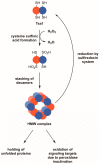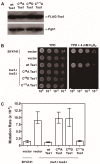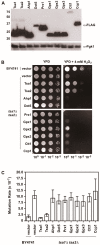Piecing Together How Peroxiredoxins Maintain Genomic Stability
- PMID: 30486489
- PMCID: PMC6316004
- DOI: 10.3390/antiox7120177
Piecing Together How Peroxiredoxins Maintain Genomic Stability
Abstract
Peroxiredoxins, a highly conserved family of thiol oxidoreductases, play a key role in oxidant detoxification by partnering with the thioredoxin system to protect against oxidative stress. In addition to their peroxidase activity, certain types of peroxiredoxins possess other biochemical activities, including assistance in preventing protein aggregation upon exposure to high levels of oxidants (molecular chaperone activity), and the transduction of redox signals to downstream proteins (redox switch activity). Mice lacking the peroxiredoxin Prdx1 exhibit an increased incidence of tumor formation, whereas baker's yeast (Saccharomyces cerevisiae) lacking the orthologous peroxiredoxin Tsa1 exhibit a mutator phenotype. Collectively, these findings suggest a potential link between peroxiredoxins, control of genomic stability, and cancer etiology. Here, we examine the potential mechanisms through which Tsa1 lowers mutation rates, taking into account its diverse biochemical roles in oxidant defense, protein homeostasis, and redox signaling as well as its interplay with thioredoxin and thioredoxin substrates, including ribonucleotide reductase. More work is needed to clarify the nuanced mechanism(s) through which this highly conserved peroxidase influences genome stability, and to determine if this mechanism is similar across a range of species.
Keywords: genomic instability; mutator; oxidative stress; peroxiredoxin; redox switch; ribonucleotide reductase; sulfiredoxin; thiol peroxidase; thioredoxin.
Conflict of interest statement
The authors declare no conflicts of interest. The funders had no role in the design of the study; in the collection, analyses, or interpretation of data; in the writing of the manuscript, or in the decision to publish the results.
Figures





Similar articles
-
The yeast Tsa1 peroxiredoxin is a ribosome-associated antioxidant.Biochem J. 2008 May 15;412(1):73-80. doi: 10.1042/BJ20071634. Biochem J. 2008. PMID: 18271751
-
Trapping redox partnerships in oxidant-sensitive proteins with a small, thiol-reactive cross-linker.Free Radic Biol Med. 2016 Dec;101:356-366. doi: 10.1016/j.freeradbiomed.2016.10.506. Epub 2016 Nov 2. Free Radic Biol Med. 2016. PMID: 27816612 Free PMC article.
-
Peroxiredoxin-null yeast cells are hypersensitive to oxidative stress and are genomically unstable.J Biol Chem. 2004 May 28;279(22):23207-13. doi: 10.1074/jbc.M402095200. Epub 2004 Mar 29. J Biol Chem. 2004. PMID: 15051715
-
The thioredoxin antioxidant system.Free Radic Biol Med. 2014 Jan;66:75-87. doi: 10.1016/j.freeradbiomed.2013.07.036. Epub 2013 Jul 27. Free Radic Biol Med. 2014. PMID: 23899494 Review.
-
The mitochondrial thioredoxin system.Antioxid Redox Signal. 2000 Winter;2(4):801-10. doi: 10.1089/ars.2000.2.4-801. Antioxid Redox Signal. 2000. PMID: 11213484 Review.
Cited by
-
Peroxiredoxin, Senescence, and Cancer.Cells. 2022 May 28;11(11):1772. doi: 10.3390/cells11111772. Cells. 2022. PMID: 35681467 Free PMC article. Review.
-
The Peroxiredoxin Asp f3 Acts as Redox Sensor in Aspergillus fumigatus.Genes (Basel). 2021 Apr 29;12(5):668. doi: 10.3390/genes12050668. Genes (Basel). 2021. PMID: 33946853 Free PMC article.
-
ROS regulation in gliomas: implications for treatment strategies.Front Immunol. 2023 Dec 7;14:1259797. doi: 10.3389/fimmu.2023.1259797. eCollection 2023. Front Immunol. 2023. PMID: 38130720 Free PMC article. Review.
-
Comparative Study of Protective Action of Exogenous 2-Cys Peroxiredoxins (Prx1 and Prx2) Under Renal Ischemia-Reperfusion Injury.Antioxidants (Basel). 2020 Jul 29;9(8):680. doi: 10.3390/antiox9080680. Antioxidants (Basel). 2020. PMID: 32751232 Free PMC article.
-
Peroxiredoxins in Cancer and Response to Radiation Therapies.Antioxidants (Basel). 2019 Jan 1;8(1):11. doi: 10.3390/antiox8010011. Antioxidants (Basel). 2019. PMID: 30609657 Free PMC article. Review.
References
Publication types
Grants and funding
LinkOut - more resources
Full Text Sources
Molecular Biology Databases
Research Materials
Miscellaneous

